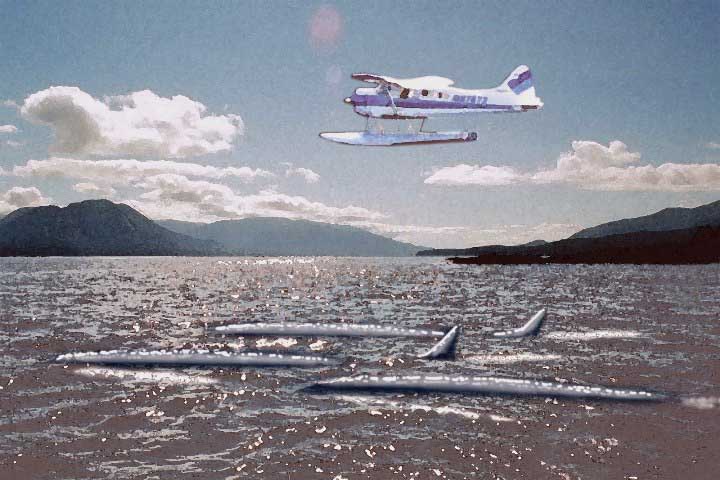Mysterious Lake Beasts of the Far North
Posted by: Craig Woolheater on February 20th, 2015
The cold, rugged expanses of the northernmost U.S. state of Alaska naturally invite wonder and awe. Here is one of the last truly great wildernesses of North America; a relatively unexplored expanse of unspoiled mountains and ancient forests unfamiliar with the touch of humankind. Tucked within the sweeping vistas of pristine wild expanses is the magnificent Lake Illiamna. Here we are the strangers, merely existing in small settlements, eking out a living on the giant lake’s shores. Extending beyond those shores are the deep waters of one of the largest lakes in the United States and under those waters lurk hulking, dark shapes that cruise below the waves. For here in the far north, in this frigid lake ensconced by boundless wilderness far from modern civilization is the supposed watery domain of one of the most enigmatic and little understood lake monsters in the world.
Lake Illiamna lies in the southwestern portion of the U.S. state of Alaska, in a remote wilderness region far from any heavily populated areas. At 77 miles (124 km) long and approximately 22 miles (35 km) wide, possessing a surface area of 1,012.5 sq mi (2,622 km2), and with depths going down to 988 feet (301 m) into the cold darkness, Lake Illiamna is the largest and deepest lake in Alaska, and indeed one of the largest lakes in the country. The lake is largely unpopulated, with only sparse settlements along its shores which rely mostly on a sustenance fishing and hunting economy, the largest of these being the village of Kakhonak with only 200 permanent residents. Due to the lake’s extremely remote location and lack of any roads leading to it, access is very limited. One of the only ways of reaching Lake Illiamna from the outside world is to use small aircraft, mostly floatplanes which can land upon the surface of the water.
This vast, far-flung, and little explored lake has long been known as the domain of some sort of enormous, fleetingly glimpsed mystery beast that locals sometimes affectionately refer to as “Illies.” Although size estimates for the creatures vary from 10 to around 30 feet long, most modern descriptions tend to be remarkably similar. The Illiamna monsters are said to have elongated, slender bodies that are of a grayish coloration, often likened to that of aluminum, that are topped off with a prominent dorsal fin regularly described as sporting a white stripe. The tail is frequently described as being vertically aligned like that of a fish rather than horizontal like that of a whale or dolphin. An interesting characteristic of the creatures is that they are always spotted lurking under the surface, alone or in groups, and are hardly known to break the surface like their more dramatic cousins such as the Loch Ness Monster.
The idea of mysterious water monsters inhabiting Lake Illiamna has a long history going back to folklore and stories passed around by the native peoples of the region. The Tlingit people spoke of a creature they called the Gonakadet; a huge aquatic animal with a body like that of an orca and a fanged, wolf-like head, that silently prowled the lake’s frigid waters. The Aleut people knew it as the jig-ik-nak, and they were said to be ferocious and highly feared monsters that attacked canoes or snatched people from shore. Early settlers to the region such as Russian fur traders as early as the 1790s also spoke of seeing such creatures.
Modern eyewitness accounts of the Illiamna lake monsters can be traced back to the 1940s, when pilots flying over the remote lake began reporting unusual, gigantic dark shapes under the placid surface. One notable such account which can arguably be credited as being the origin of the modern Lake Illiamna monster craze was a sighting made in 1942 by bush pilot and fishing guide Babe Alyesworth, along with companion Bill Hammersley, who were flying over the lake in a small aircraft when they spotted several dozen mysterious, fish-like shapes over 10 feet long with vertical tails and looking like “mini submarines” swimming along under the surface in shallow water around 40 feet deep. Alyesworth gave many of these details in a personal interview with cryptozoologist Loren Coleman in 1988, which is mentioned in Coleman and Jerome Clark’s comprehensive cryptozoology tome Cryptozoology A to Z: The Encyclopedia of Loch Monsters, Sasquatch, Chupacabras, and Other Authentic Mysteries of Nature. It is also mentioned in their book that in 1959, Alyesworth claimed he was hired by wealthy oil tycoon and cryptozoology aficionado Tom Slick for the purpose of carrying out an aerial survey of the lake in search of the creatures, even going so far as to put out buoys with lines on them, but nothing was found. The book also describes how the other witness aboard the flight, Hammersley, went on to write an article in 1947 on his experience in an effort to drum up interest and get people to come forward with their own accounts. A similar sighting mentioned in the book was made by a survey pilot named Larry Rost in 1945, when he saw a large, elongated animal reportedly 20 feet long in the lake as he flew at very low altitude. Rost reportedly came forward with this account after hearing of Hammersley’s own sighting.

Read the rest of the article here.
See also:
Is Illie A Sleeper Shark?
Are Lake Illiamna Monsters Getting Rattled?
About Craig Woolheater
Co-founder of Cryptomundo in 2005.
I have appeared in or contributed to the following TV programs, documentaries and films:
OLN's Mysterious Encounters: "Caddo Critter", Southern Fried Bigfoot, Travel Channel's Weird Travels: "Bigfoot", History Channel's MonsterQuest: "Swamp Stalker", The Wild Man of the Navidad, Destination America's Monsters and Mysteries in America: Texas Terror - Lake Worth Monster, Animal Planet's Finding Bigfoot: Return to Boggy Creek and Beast of the Bayou.








